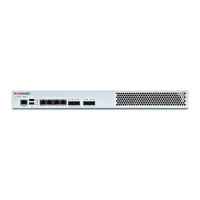How to set up your FortiWAN Configuring Network Interface (Network Setting)
Subnet : The IPv6 subnet deployed on the WAN link.
DMZ Port : The DMZ port for the IPv6 subnet.
Enable DHCP : Check to enable DHCP.
DHCP Range : Specify the range of IPv4 addresses for DHCP to use.
Static Mapping : Specify the static mapping between IPv4 Addresses and MAC addresses.
Enable DHCPv6 Service : Check to enable DHCPv6.
DHCP Range : Specify the range of IPv6 addresses for DHCP to use.
Static Mapping : Specify the static mapping between IPv6 Addresses and client IDs.
The SLAAC and DHCPv6 in FortiWAN are designed to work together, which the SLAAC responses router
advertisement (including default gateway and DNS server) to a host and DHCPv6 responses the host an appropriate
IPv6 address.
This topology can be seen where a group of valid IP addresses ranging 211.21.40.32~211.21.40.34 have been given
by ISP and assigned to port1 on FortiWAN. And their default gateway is 211.21.40.254 given by ISP as well.
If there are other hosts deployed on the WAN, then configure their IP addresses in [IP(s) in WAN]. And if there are
hosts deployed on the DMZ, then configure their IP addresses in [IP(s) in DMZ]. Check [Enable DHCP] if hosts in the
subnet in DMZ require DHCP service. And enter the starting and ending address in [DHCP Range]. If any host in the
subnet uses static IP address, then in [Static Mapping], enter its IP and MAC address.
See also
l
WAN link and WAN port
l
VLAN and port mapping
l
Configurations for VLAN and Port Mapping
l
Outbound Load Balancing and Failover (Auto Routing)
l
Inbound Load Balancing and Failover (Multihoming)
l
Scenarios to deploy subnets
l
Public IP pass through (DMZ Transparent Mode)
l
IPv6/IPv4 Dual Stack
Configurations for a WAN link in Bridge Mode: One Static IP
[Bridge Mode: One Static IP] is used when ISP gives one static IPv4 address to a user. Usually, the IPv4 address a
user obtained is one IP address of a C class IPv4 network; it is indicated by the netmask 255.255.255.0. The default
gateway that ISP assigned is located at ISP’s network, while the ATU-R works in bridge mode. FortiWAN’s Bridge
Mode: One Static IP is suggested to apply for this case. IPv6/IPv4 dual static is supported for FortiWAN’s Bridge
Mode: One Static IP. In the dual static similar as previous case, ISP might provide you a WAN IPv6 subnet and a LAN
IPv6 subnet. You can deploy the LAN IPv6 subnet as a basic subnet in DMZ. Although the deployment is under
FortiWAN’s Bridge Mode, FortiWAN routes packets between WAN and DMZ for the IPv6 subnets. Basic subnets are
not supported for IPv4 network deployed in Bridge Mode. The following topology is widely seen where a user gets one
static IP from ISP.
45 FortiWAN Handbook
Fortinet Technologies Inc.

